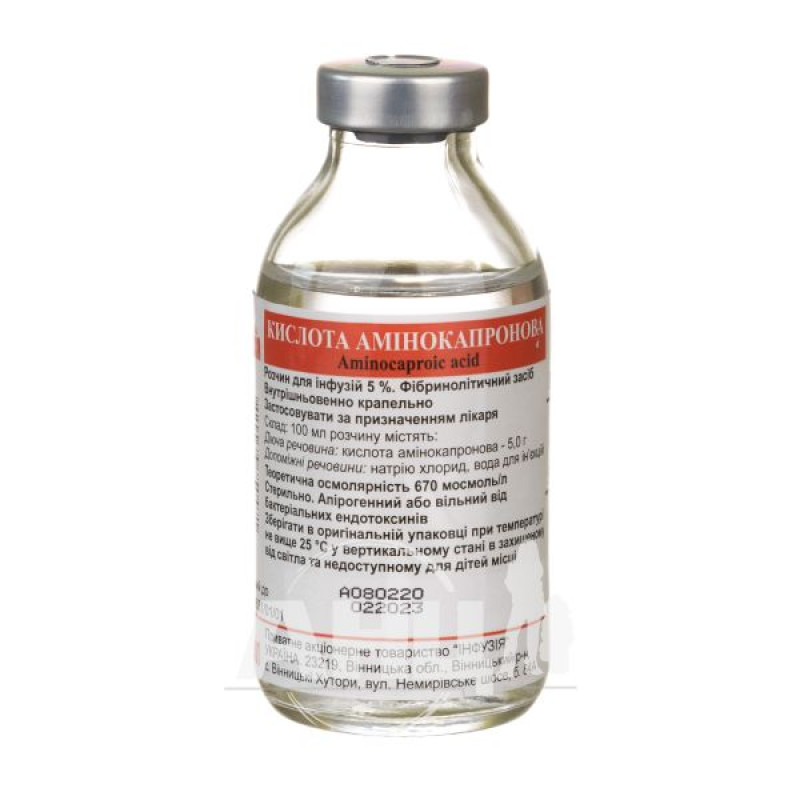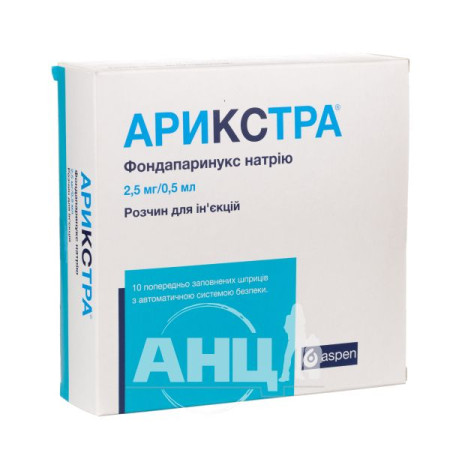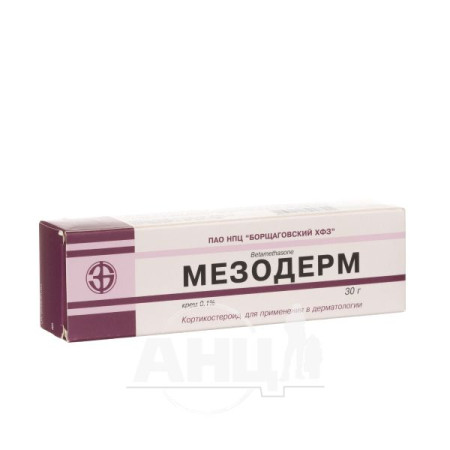Aminocaproic acid solution for infusion 5% bottle 100 ml

Translation of the instructions can be
AMINOCAPROIC ACID solution for infusion 5%Instruction
For medical use of the medicinal product
Aminocaproic acid
(Aminocaproic acid)
Composition:
Active ingredient: aminocaproic acid;
100 ml of solution contain 5 g of aminocaproic acid;
Excipients: sodium chloride, water for injections.
Dosage form.
Solution for infusion.
Main physicochemical properties: clear colorless liquid.
Pharmacotherapeutic group.
Antihemorrhagic agents. Fibrinolysis inhibitors. ATC code B02A A01.
Pharmacological properties.
Pharmacodynamics.
Aminocaproic acid solution has a hemostatic, antifibrinolytic effect in bleeding caused by increased fibrinolysis. Its action is associated with the blockade of plasminogen activators and partial inhibition of the effect of plasmin. The drug also inhibits biogenic polypeptides - kinins. Promotes the stabilization of fibrin and its deposition in the vascular bed, induces platelet and erythrocyte aggregation.
Aminocaproic acid exhibits antiallergic, antiviral effects, enhances the detoxification function of the liver. Inhibits the proteolytic activity associated with the influenza virus. Aminocaproic acid slows down the effect on the early stages of the interaction of the virus with sensitive cells, and also inhibits the proteolytic processing of hemagglutinin. As a result, a functionally active protein of the influenza virus, which ensures its infectious activity, is not created, and the amount of daughter infectious virus is reduced. Aminocaproic acid not only exhibits antiviral activity, but also improves some cell and humoral indicators of specific and nonspecific protection of the body in respiratory viral infections.
Pharmacokinetics.
When administered intravenously, the effect is manifested after 15-20 minutes. It is rapidly excreted by the kidneys: 40-60% of the administered amount is excreted in the urine after 4 hours. In case of impaired renal excretory function, the concentration of aminocaproic acid in the blood increases significantly.
Clinical characteristics.
Indication.
Bleeding after surgical operations and various pathological conditions associated with increased fibrinolytic activity of blood and tissues.
To prevent the development of secondary hypofibrinogenemia during massive transfusions of preserved blood.
Treatment and prevention of influenza and acute respiratory viral infections in children and adults.
Contraindication.
Hypersensitivity to the components of the drug; predisposition to thrombosis and thromboembolic diseases; coagulopathy due to diffuse intravascular coagulation; kidney disease with impaired function, renal failure; hematuria; pregnancy, childbirth, breastfeeding; severe ischemic heart disease; cerebral circulation disorders.
Interaction with other drugs and other types of interactions.
The effect of the drug is weakened by anticoagulants and antiplatelet agents of direct and indirect action. Simultaneous use with estrogen-containing contraceptives, blood clotting factors IX increases the risk of thromboembolism. Use with caution in patients taking retinoids (including tretinoin).
Application features.
With intravenous administration, it is necessary to monitor the coagulogram, especially in ischemic heart disease, after myocardial infarction, with pathological processes in the liver. In case of hematuria, the drug is not recommended due to the risk of acute renal failure. It is recommended to exclude fatty foods during treatment with the drug.
Use with caution in patients with heart disease. If it is necessary to use the drug in patients with heart disease, it is recommended to monitor the level of creatine phosphokinase in the blood plasma. Do not use the remaining drug.
Use during pregnancy or breastfeeding.
The drug is contraindicated during pregnancy. It is not advisable to use it in women to prevent increased blood loss during childbirth, as thromboembolic complications may occur.
If necessary, use of the drug should be discontinued.
The ability to influence the reaction speed when driving vehicles or other mechanisms.
During treatment, refrain from driving and performing potentially dangerous activities due to possible adverse reactions from the central nervous system.
Method of administration and doses.
Aminocaproic acid solution should be administered orally or intravenously.
Adults should be given 5 g (100 ml) of the drug orally. Then 1 g (20 ml) every hour for 8 hours until the bleeding stops completely.
If it is necessary to achieve a rapid effect (acute hypofibrinogenemia), administer intravenously drip up to 100 ml of solution (5 g) at a rate of 50-60 drops per minute for 15-30 minutes. During the first hour, administer in a dose of 4-5 g, and with continued bleeding - until it stops completely - administer 1 g every hour, but not more than 8 hours.
If bleeding recurs, repeat the administration of the 5% solution.
Children.
In acute bleeding, the doses are:
for children under 1 year: single dose - 5 ml; daily dose - 30 ml; from 2 to 4 years: single dose - 5-7.5 ml; daily dose - 30-45 ml; from 5 to 8 years: single dose - 7.5-10 ml; daily dose - 45-60 ml; from 9 to 10 years: single dose - 15 ml; daily dose - 90 ml; from 11 to 14 years: single dose - 20 ml; daily dose - 120 ml; from 15 to 18 years: single dose - 28 ml; daily dose - 160 ml.The course of treatment is from 3 to 14 days.
For the prevention and treatment of influenza and acute respiratory viral infections, the drug should be used orally and topically (0.5-1 ml in the nose 3-4 times a day).
The drug should be administered orally to children in doses:
children under 2 years old - 1-2 g (20-40 ml of 5% solution per day) - 1-2 teaspoons 4 times a day (0.02-0.04 g/kg - single dose), can be added to food or drinks; children from 2 to 6 years old - 2-4 g (40-80 ml of 5% solution per day) - 1-2 tablespoons 4 times a day; children from 7 years old and adults - 4-5 g (80-100 ml of 5% solution per day), dividing the daily dose into 4 doses.For more accurate dosing of the solution, it is advisable to use a medical syringe without a needle with a volume of 10 or 20 ml.
At the same time, it is advisable to use aminocaproic acid topically. It is recommended to insert cotton swabs moistened with a 5% solution of aminocaproic acid into each nostril for 5-10 minutes every 3-4 hours, or to instill 3-5 drops of the drug into each nostril at the specified times.
Aminocaproic acid can be used in combination with other antiviral drugs and interferon and its inducers, if necessary.
Intranasal instillations of aminocaproic acid (3-4 times a day) are advisable during the epidemic period to prevent influenza, which can be supplemented by enteral (as in treatment) use of the drug in foci of infection upon contact with the patient.
The duration of oral administration of aminocaproic acid for influenza and acute respiratory viral infections is 3-7 days.
The duration of treatment depends on the severity of the disease and is determined by the doctor individually. The doctor may also adjust the dose and prescribe a repeated course of treatment.
Children.
There are no data on restrictions on the use of the drug in children.
Overdose.
A sharp decrease in fibrinolytic activity of the blood. pronounced symptoms of side effects: dizziness, nausea, diarrhea, skin rashes, orthostatic hypotension, convulsions, headache, nasal congestion, acute renal failure, rhabdomyolysis, myoglobinuria. increased adverse reactions, blood clot formation, embolism. with prolonged use (more than 6 days) of high doses (for adults - more than 24 g per day) - hemorrhages.
Treatment: In case of overdose, discontinue administration of the drug and provide appropriate symptomatic therapy.
Adverse reactions.
Cardiovascular system: orthostatic hypotension, subendocardial hemorrhage, bradycardia, arrhythmia.
On the part of the digestive system: nausea, diarrhea, vomiting.
From the side of the blood coagulation system: blood clotting disorders, with prolonged use (more than 6 days) of high doses (for adults - more than 24 g per day) - hemorrhages.
From the side of the central nervous system: headache, dizziness, tinnitus, convulsions.
On the part of the immune system: hypersensitivity reactions, including allergic reactions, rash, nasal congestion, catarrhal phenomena of the upper respiratory tract.
General disorders: changes at the injection site.
Other: myoglobinuria, rhabdomyolysis, acute renal failure. With an increase in the rate of administration, bradycardia, extrasystole, chills, fever are possible.
Expiration date.
3 years.
Storage conditions.
Store in the original packaging at a temperature not exceeding 25 °C in an upright position, protected from light and out of the reach of children.
Incompatibility.
During infusion, do not mix in the same container with other infusion solutions.
Packaging.
100 ml in bottles.
Vacation category.
According to the recipe.
Producer.
Private Joint Stock Company "Infusion".
Location of production and its address of place of business.
Ukraine, 21034 Vinnytsia, Voloshkova St., 55
or
Ukraine, 23219, Vinnytsia region, Vinnytsia district, Vinnytskie Khutory village, Nemyrivske highway st., 84A
Applicant.
Private Joint Stock Company "Infusion".
Location of the applicant and/or the applicant's representative.
Ukraine, 04073, Kyiv, Moskovsky Prospect, 21-a.
There are no reviews for this product.
There are no reviews for this product, be the first to leave your review.
No questions about this product, be the first and ask your question.


